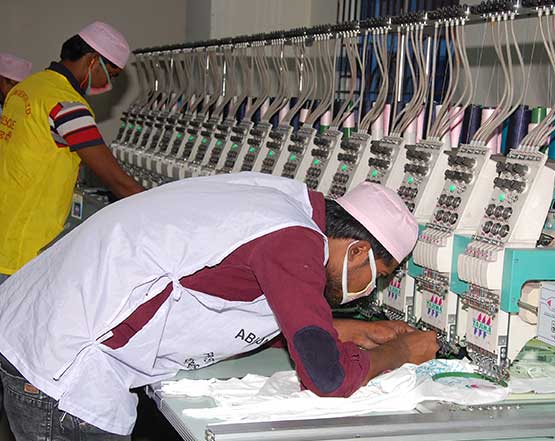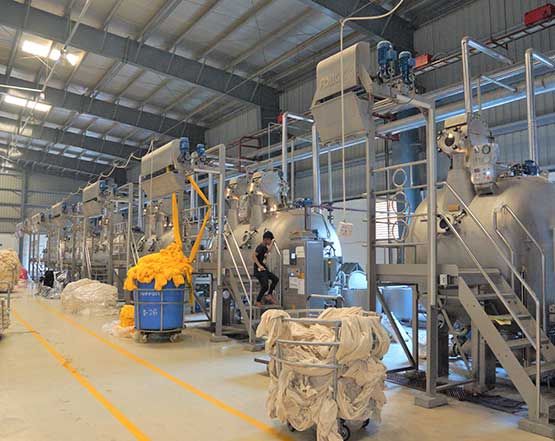DEPARTMENTS
Garments
Sample Department
The sample department is the start of the garment development. When the buyer decides on what color they want to buy. The sample department representatives dye fabrics for each color, compile all the necessary accessories, cut and print those fabrics, and later makes the sample and brings it all together.
The sample is then sent to you for final approval. After that, we are allowed to go for bulk production. Our sampling department can make and deliver up to 50 samples per day. Their dedicated workforce knows that the sample must be on point, to satisfy and amaze our clients.
Knitting Section
These machines knit the yarn into grey fabrics. The knitting section is where we have to keep a keen eye on quality. A company-wide focus on commitment to ensure the best quality starts here. Ensuring minimum wastage through defect monitoring and fabrics checking these fabrics travel to our dyeing facility all ready to be dyed into their respective colors. Variety in machine sizes and specifications helps to offer the consumers a wide range of diameters and knitting patterns. A lot of the patterns starting from Single Jersey, Pique, Lacoste, Terry, Stripes, and Ribs are done in-house in our own facility.
Cutting Section
Cutting is the first part of the process when it enters the garment manufacturing factory. Upon entering the section, a spreading machine can be seen laying the fabrics one over another. Pattern makers are laid on top of the fabrics that have been laid. Employees then use fabric cutting machines to almost slice into the lays according to their respective patterns.
The stacks of cut fabrics are then marked and sent down to the input section, where they will be sent to either printing, embroidery, or directly to the sewing lines, depending on the design of the order.
Printing Section
Prints are the life of the garments we wear. It adds colors to the basic items and this is what makes a design unique. Making a lot of types of prints available for our customers opens up a wide range of possibilities for designs.
Photo Print, Disperse Prints, Pigment Prints, Rubber Prints, High-Density Prints, Glitter Prints, and Puff Prints are a few of the most popular types of prints that are offered. Abloom’s printing plant can accommodate up to 40,000 pcs orders per day.
Embroidery Section
Embroidery on any item can make your products pop. Top-of-the-line embroidery machines from Japan can do up to 4000 pcs per day. There are a wide variety of effects that can be generated like applique, metal, and logos.
Abloom’s attention to detail helps produce very clear and better embroidery quality.
Sewing Section
This is the palace where the products take their shape. Abloom and NRR combined have 17 sewing lines capable of producing up to 46,000 pcs per day. Our expert workers are all committed to quality and provide their best every single day, day in and day out.
Abloom and its sewing workforce are always ready to facilitate the new trends of the market. Every piece of the garment goes through initial checking and makes sure that the products are of a great standard.
Finishing Section
There is a lot that goes on in this department. The role of this department cannot be emphasized enough. After sewing, the goods are checked and counted and they arrive in this department. The products are first ironed through steam irons, the in-line supervisors make sure that the iron quality is up to the mark.
The products are then passed on to the final checking table. Here the products go through a rigorous checking process. The faulty items are sorted out. Later price tags and stickers are attached to each order according to the way you want it to. The goods can then be put into their poly bags and packed inside cartons. All these processes are done in a continuous process. The companies finishing section can finish and pack almost 46,000 pcs of items per month.
DYEING
Lab Department
A company’s technical expertise comes from the Lab. As a result, Abloom has invested heavily in its Lab department. Our state-of-the-art facility has 3 Lab dyeing machines, Data color Spectro photo-meter, Light Boxes, Rubbing Testing, Wash Fastness Testing, Shrinkage and Twisting Measuring, and Ph Testing machines. This department makes Lab dips out of the swatches as well as the Pantone numbers as the buyer provides.
The Lab Dips are sent to the buyers, in order to get their approval. If it is not suitable Lab dips are developed again and this process is repeated till the buyer approves of the color they want to buy. Abloom checks the quality of the fabrics being produced, continuously as the order is being executed. Making sure every batch of fabrics meets the quality standers of our clients and making them satisfied with our level of quality.
Dyeing Department
After the batch of grey fabrics is ready, we dye them, according to the consumer’s approved colors. The fabrics are loaded in any of our 20 Dyeing machines. The dyeing facility has 20 tons of dyeing capacity/ day. Each batch takes approximately 6-10 hours, depending on the color on Abloom’s state-of-the-art High Temperature (HT), High Pressure (HP) machines.
Quality is controlled in a few steps throughout the dyeing process. A lot of the quality depends upon the operator. All of our trained and experienced operators work with precision, in order to bring the best quality of shade, softness, and other parameters.
Finishing Department
While finishing, we need to pass the fabric through a few processes. For every batch, the finishing department passes one roll of fabrics through first. This helps determine and modify if there are any changes that we need to make in the entire batch.
The facility can finish in both open and tube processes, whichever the customer requires.










